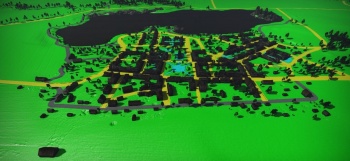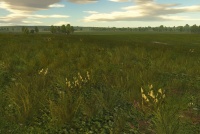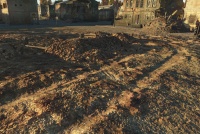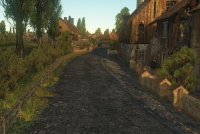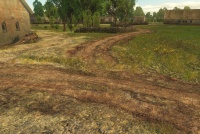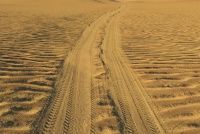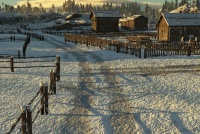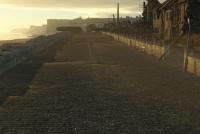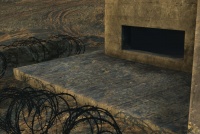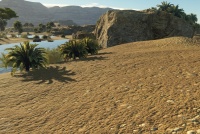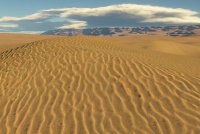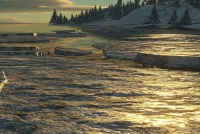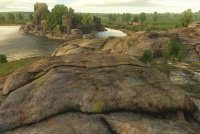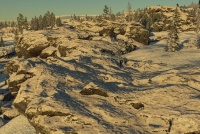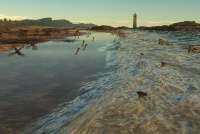Effects of terrain types on ground vehicles
Contents
In War Thunder ground battles, multi-ton steel vehicles have to move over various types of terrain, including flat fields or sand dunes. This article takes a detailed look at game terrains and how exactly metal tracks or rubber tyres of heavy combat vehicles interact with different types of terrain.
Basic concepts
First, two basic concepts should be defined:
Traction, or simply "grip", is how well the tracks or wheels "grip" the surface. Good traction means that the tank or vehicle has a low chance of slipping and therefore reduces the chance of the vehicle skidding or sliding down hills.
On pressure-sensitive surfaces, traction is produced when special grousers on the tracks or rubber tyre are pressed into the ground. On hard, non-deformable surfaces, traction will depend primarily on the friction between the track or wheel tyre and the surface. If the surface is too hard and wet, this will significantly reduce traction and the wheel or track may begin to slip, resulting in poor acceleration and a significantly increased chance of skidding.
Surface looseness - or its density. The denser or more compact the surface, the less susceptible it is to pressure from tracks or wheels. Conversely, the less dense it is, the deeper the machines will bind in it. A surface that is too loose can make it very difficult for machinery to move, as it will slip in place more often.
While it would seem that the more dense the ground beneath the tank the better, because increased density should also increase traction, this is not always the case. Indeed, the deeper into the ground the track (or wheel) of the vehicle goes, the tighter it is surrounded by soil particles, but during further scrolling of this track almost all surface particles clogged between tracks and lugs are cut off and thrown from this track behind the vehicle. Therefore, the actual quality of traction of a track or wheel on a dense surface depends primarily on the resistance of the ground to shearing, i.e. the internal friction force between the particles in that ground. If loose sand is placed under the track or wheel, due to the hardness and poor bonding of the loose sand grains, they will roll freely with the track or wheel and the grip quality will remain poor, which will increase the number of idle turns of the track. If, instead of sand, you get snow that has the same density, the "stickiness" of the squeezed snowflakes will create enough friction and idle turns of the track or wheel will be much less, and therefore the speed will be much better.
As a general rule of thumb, the better the grip and the lower the looseness of the surface, the faster the machine can reach and maintain maximum speed and the less chance of skidding. It is worth remembering that machines with wider tracks have better traction due to increased surface friction, while wheeled machines have worse traction compared to tracked machines.
Game surface types
|
Normal dirt - Most of the game maps are covered by ordinary dirt, so this type of surface should be familiar to all participants in tank battles. In general terms we can say that simple dirt provides good grip and traction. |
Mud - which tanks are not afraid of, but avoid anyway. Wet mud is not common, but this is a good thing, as it seriously reduces the movement speed of all vehicles. Usually mud can be found in the craters formed by bombs or near freshly dug trenches. Due to its physical properties, mud is very viscous, which makes it very difficult to move. Tanks and wheeled vehicles rolling across muddy terrain always leave behind deep and clearly visible tracks. |
|
Paved road - A luxury in the midst of war. Roads are laid out specifically to make them easy to drive on, and as such, driving on them in the game is truly convenient! Good roads are often found in urban areas and are very useful for any type of vehicle, displaying their best characteristics on the surface, while virtually eliminating the likelihood of skidding. |
Dirt road - If there are no roads, make them yourself! A well-packed track rolled by dozens of columns would do well for this title. Of course, a dirt road is not as good as a full and thoroughly paved track, but it is still much better than being completely off-road. A dirt road has good traction, but you won't get as fast on it as you would on a regular road. |
|
Sandy road - Rolled sand can often have all the hallmarks of a good road. The sandy road provides good grip and is as easy to grip as the packed dirt road. It is highly preferable for wheeled vehicles and won't harm any other vehicles at all. Sandy locations are generally very hard on any vehicle, so you should never neglect getting to a favourable location faster than your opponents. |
Snow-covered road - Possibly a normal road, or maybe just a rolled path in the fresh snow. If we're going to choose a path, it might as well be a well-trodden one. Nobody knows for sure what exactly is under the snow, but any road looks more reliable than the lack of it. On a snow-covered road the machinery moves at a normal speed, but the grip is a little worse. |
|
Paving stones - Most of the city's streets and pavements are lined with paving stones. Tiles or cobblestones were laid in even rows and knocked into each other. On such a surface, there is virtually nothing to catch the track on hard braking and therefore the probability of skidding increases, but you can gain speed without too much trouble. |
Concrete - Due to the high cost of actually pouring such a surface, it is also not often seen in the game. As in the case of paving stones, concrete is not very "skid-proof", but also does not prevent vehicles from reaching their normal speed. |
|
Sand - is coarse and rough and gets everywhere. Most desert locations are covered in sand, making it one of the least pleasant surfaces for any tank player. The loose sand slows movement and manoeuvring, and makes vehicles, particularly wheeled vehicles, prone to skidding and rolling down steep gradients. |
Sand dunes - get on the tanker's nerves even more than ordinary sand. Sand dunes are formed by sustained winds, but unlike sand that has become frozen, the sand in the dunes is even looser. Sand in dunes has even worse grip and viscosity than ordinary compacted sand, so you should not expect anything good from it. |
|
Snow - Cold, soft, and crunchy. Many people love white, untouched snow, but when heavy steel cars are rushing in this snow, the situation starts to look a little different. It noticeably interferes with the tanks' ability to properly gain speed. When driving in snow, traction is also impaired, which often leads to skidding. Still, better snow than sand. |
Ice - equally cold and crisp, but hard almost like stone. A very slippery and hard surface. Ice is not common in the game, but that's no reason to try to get on it. Ice has the worst grip. The heaviest skidding can be achieved on ice, and due to slippage of tracks and tyres, speed is not gained too quickly. |
|
Rocks - Rocky ledges are found here and there in the game and are truly rock hard. Care must be taken when navigating over the rocks, as the grip on the surface is somewhat reduced. Of course, there is no viscosity in the stones, and it allows the tanks to develop speed at a normal pace. |
Icy rocks - also rock, but even more slippery. Icy rocks pose a danger not only to climbers, but also to inattentive tank drivers. The grip on icy rocks is even worse than on ordinary rocks, though better than on free ice, still you can slip sideways off another rock and end up in a hopeless situation. The speed on icy rocks is also slightly worse than on normal rocks. |
|
Water - is not a surface but a medium, but nevertheless it also affects the speed of vehicles. Only fish and skilled swimmers retain their nimbleness in water, but steel tanks and cars do not fall into either category. In water the speed of all land vehicles is seriously reduced (even the amphibious ones), no matter what is on the bottom, even if it is a road. Also, do not get carried away and drive into the depths, because the crew of the vehicle can easily drown. |


